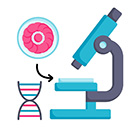
Living with Uterine Fibroids: A Fertility Specialist’s Perspective
When I first started working as a fertility specialist, I encountered a patient who forever changed the way I view uterine fibroids and their impact on fertility. Her name was Anna, and she came into my office visibly nervous, clutching a stack of medical reports. At 36, she had spent the past two years trying to conceive with no success. Her gynecologist had discovered several uterine fibroids, and she was told they might be the cause of her infertility. This was my first real introduction to just how complicated and personal this issue could be.
I’ve since met many patients like Anna, and each case has its unique challenges and insights. Uterine fibroids are a common condition, but their effect on fertility is anything but straightforward. Let me take you through what I’ve learned from working with patients over the years.

What Are Uterine Fibroids?
Uterine fibroids are non-cancerous growths that develop in or around the uterus. They vary widely in size, number, and location, which makes their impact on fertility highly individualized. Some women have small fibroids that cause no symptoms, while others deal with large, painful ones that can disrupt their lives.
Dr. Emily Carter, a leading OB-GYN, explains, “The location of a fibroid often determines its effect on fertility. For instance, submucosal fibroids—those growing inside the uterine cavity—are more likely to interfere with implantation or cause miscarriages.”

How Fibroids Affect Fertility
Not all fibroids lead to infertility, but they can create obstacles depending on their characteristics. Here are the primary ways fibroids can complicate conception:
- Interfering with Implantation: Fibroids inside the uterine cavity can distort the uterine lining, making it harder for an embryo to implant.
- Blocking the Fallopian Tubes: Large fibroids can physically block the fallopian tubes, preventing sperm and egg from meeting.
- Disrupting Blood Flow: Some fibroids reduce blood flow to the uterus, impacting the ability to sustain a pregnancy.
- Causing Recurrent Miscarriages: Fibroids can create an unfavorable environment for a growing fetus, increasing the risk of pregnancy loss.
One of my patients, Rachel, had a fibroid pressing on her fallopian tube, which prevented her from ovulating properly. After a minimally invasive surgery to remove it, she conceived naturally within six months. Cases like hers remind me how powerful the right intervention can be.

Diagnosing and Treating Fibroids
The first step in addressing fibroids is accurate diagnosis. Most patients learn about their fibroids during routine ultrasounds, but advanced imaging like an MRI is sometimes needed to get a clearer picture.
Treatment depends on the severity of the symptoms and the patient’s fertility goals. Some options include:
- Medications: Hormonal treatments can shrink fibroids temporarily, but they’re not a long-term solution for women trying to conceive.
- Surgery: Procedures like myomectomy, which removes fibroids while preserving the uterus, are often recommended for women planning to get pregnant.
- Minimally Invasive Techniques: Newer approaches like uterine artery embolization are less invasive but might not be ideal for women hoping to conceive.
Dr. James Wells, a reproductive surgeon, notes, “The goal with fibroid surgery is not just to remove the fibroids but to preserve and restore the uterine structure. It’s a delicate balance.”
The Emotional Toll of Fibroids
Beyond the physical challenges, fibroids take a significant emotional toll on patients. I’ve had patients break down in tears during consultations, frustrated by years of failed attempts to conceive. Many women feel a sense of betrayal by their own bodies.
Anna, the patient I mentioned earlier, shared with me, “I felt like my body was sabotaging my dream of becoming a mother. Every time I saw a pregnant woman, it was like a punch in the gut.” Her honesty highlighted the deep emotional scars fibroids can leave behind.
That’s why it’s essential to address not just the medical side of fibroids but also the emotional aspect. Support groups, therapy, and open communication with healthcare providers can make a world of difference.
Hope and Success Stories
Despite the challenges, there’s plenty of hope for women with fibroids. Advanced medical techniques and personalized care have helped countless women achieve their dream of motherhood. I’ve had the privilege of seeing patients like Anna and Rachel go from heartbreak to joy.
Dr. Karen Blake, a fertility specialist, sums it up beautifully: “Fibroids are a hurdle, not a wall. With the right care, most women can overcome them and go on to have healthy pregnancies.”
My Final Thoughts
As a fertility specialist, I’ve learned that uterine fibroids are more than just a medical condition—they’re a deeply personal struggle for many women. They require empathy, understanding, and a tailored approach to treatment. Each patient teaches me something new, and their resilience inspires me every day.
If you’re dealing with fibroids and infertility, know that you’re not alone. There are solutions, and there is hope. The journey might be challenging, but with the right support, motherhood is still within reach.







